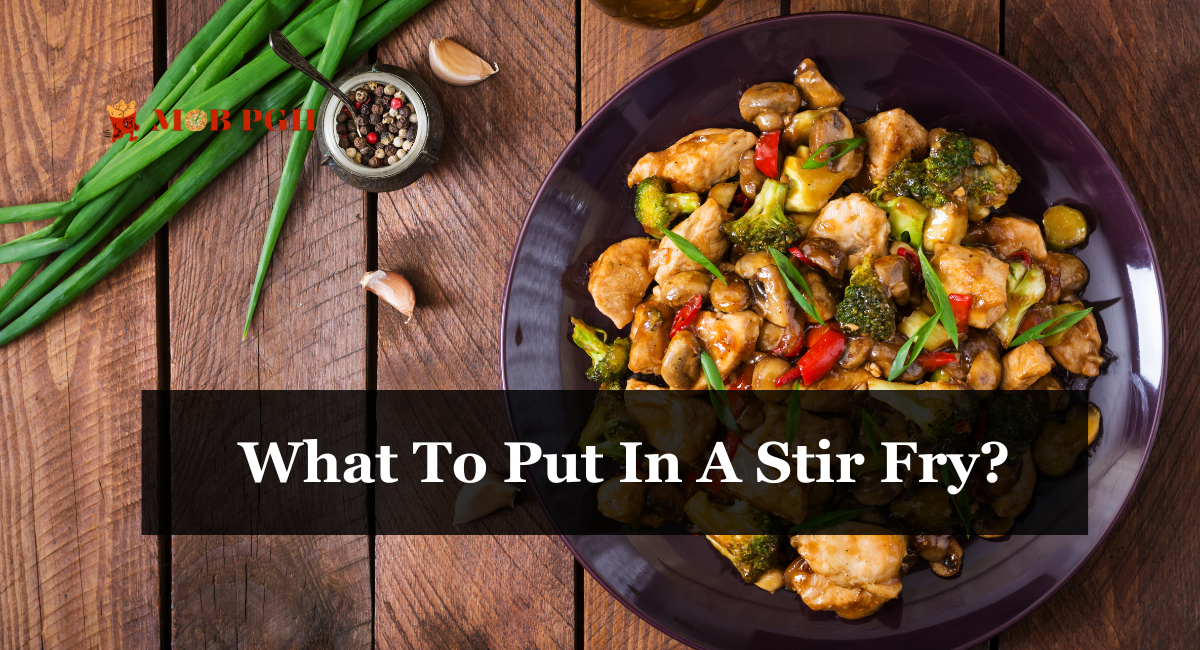Stir-frying is an adaptable and delectable cooking method that originated in China and has since become a worldwide preference. This method involves rapidly sauteing bite-sized pieces of meat, vegetables, and sometimes tofu in a hot pan or wok, resulting in a dish that is not only flavorful but also nutrient-dense. Stir-frying’s appeal rests in its simplicity, speed, and versatility. Creating a delicious stir-fry is well within your reach, regardless of your culinary expertise. This article, will explain what to put in a stir fry.
What Exactly Is Stir Fry?
Stir fry is a high-temperature culinary technique that originated in Asian cuisine. In a wok or skillet, bite-sized pieces of protein (such as poultry, beef, or tofu) and a variety of vegetables are quickly sautéed. These ingredients are prepared in a flavorful sauce typically made with soy sauce, ginger, and garlic, resulting in a quick and delectable one-pan dish. Stir-frying preserves the ingredients’ vibrant colors, textures, and nutritional value, making it a popular and versatile cooking method.
What To Put In A Stir Fry?
1. Protein
- Sliced Meat: Standard options for sliced meat in stir-fries include chicken, beef, pork, and seafood. Thinly slicing the meat will ensure that it cooks swiftly and evenly. Before stir-frying the meat, marinating it in a mixture of soy sauce, ginger, and garlic can enhance its flavor.
- Tofu or Tempeh: Both tofu and tempeh Vegetarians and vegans can get a lot of energy from tofu and tempeh. You can slice or grind tempeh, and you can cube and stir-fry extra-firm tofu.
2. Vegetables
The choice of vegetables in a stir-fry can considerably affect the flavor and texture of the dish. Choose a mixture of the following:
- Bell Peppers: Red, green, and yellow bell peppers lend sweetness and vibrant color to stir-fry dishes.
- Broccoli: Broccoli florets and stems have a gratifying crunch and an earthy taste.
- Snap Peas: These snap peas have a delightful crunch and a hint of sweetness.
- Carrots: For color and a suggestion of sweetness, julienne or thinly sliced carrots.
- Mushrooms: Sliced shiitake, cremini, or button mushrooms enhance the umami flavor.
- Zucchini: Zucchini possesses a delicate, mellow flavor and a tender texture.
- Bok Choy: Baby bok choy is a classic ingredient in Asian stir-fries due to its mild, barely peppery flavor.
- Asparagus: These slender segments of asparagus add a crisp and vibrant element to your dish.
- Baby Corn: Baby corn has a distinct visual appeal and a sweet, mild flavor.
3. Aromatics
- Garlic: Freshly minced garlic is essential for flavoring stir-fries. You can adjust the quantity to your liking.
- Ginger: Fresh ginger, grated or cut thinly, imparts a zesty, aromatic note to the dish.
- Green Onions (Scallions): For a mild flavor, slice green onions into rounds and use white and green portions.
4. Sauces
- Soy Sauce: The primary source of salinity and umami in a stir-fry is regular or low-sodium soy sauce.
- Oyster Sauce: Oyster sauce gives your sauce a lush, savory-sweet dimension.
- Hoisin Sauce: This lends sweetness and complexity to the flavor profile with Hoisin sauce.
- Teriyaki Sauce: Teriyaki Sauce combines soy sauce, sugar, and mirin for a mildly sweet and salty flavor.
- Sesame Oil: A small amount of sesame oil drizzled at the end can enhance the overall aroma and flavor.
5. Nuts And Seeds (optional)
- Cashews: Cashews have a delectable crunch and nutty flavor when roasted.
- Peanuts: Crushed peanuts can impart a unique texture and nutty flavor to a dish.
- Sesame Seeds: Toasted sesame seeds can be scattered on the stir-fry as a nutty and aromatic garnish.
6. Oil
To stir-fry your ingredients, select a high-heat culinary oil such as vegetable oil, peanut oil, or grapeseed oil. These oils have high smoke points, making them suitable for stir-frying’s high-temperature cooking.
7. Rice Or Noodles (optional)
Serve your stir-fry over steamed rice or cooked noodles such as rice, udon, or egg noodles for a complete entrée. Be sure to prepare them separately and incorporate them when the stir-fry is almost finished cooking.
8. Seasonings
To taste, add salt, pepper, or other seasonings. Remember that the sauces you employ may already contain ample seasoning, so taste as you go and modify as necessary.
Tips
Two essential tips for preparing stir fry at home are:
- Use a large skillet or wok and high fire: If your pan is too small, there will not be enough surface area for the vapors to evaporate, resulting in soupy vegetables. Similarly, if the temperature is insufficient, the steam will not evaporate quickly enough, and the vegetables will become soupy.
- Be careful not to overcook the vegetables: You want the vegetables to be tender-crunchy and brilliantly hued. You can always cook them a little longer after adding the sauce, but if you cook them too long in the first stages, you will end up with limp, colorless vegetables.
The culinary discipline of stir-frying combines flavors, textures, and colors in a single sizzling pan. By following the guidelines and recipes provided, you can discover the secrets to mastering this technique and create an assortment of delectable stir-fry dishes. Embrace the sizzling, experiment with ingredients, and bring a taste of Asia to your kitchen with the ultimate stir-fry. Your taste senses will appreciate your newfound culinary skills, and your friends and family will be impressed.
Best wishes while stir-frying!
Read More: Best Way To Cook Rice On Stove

